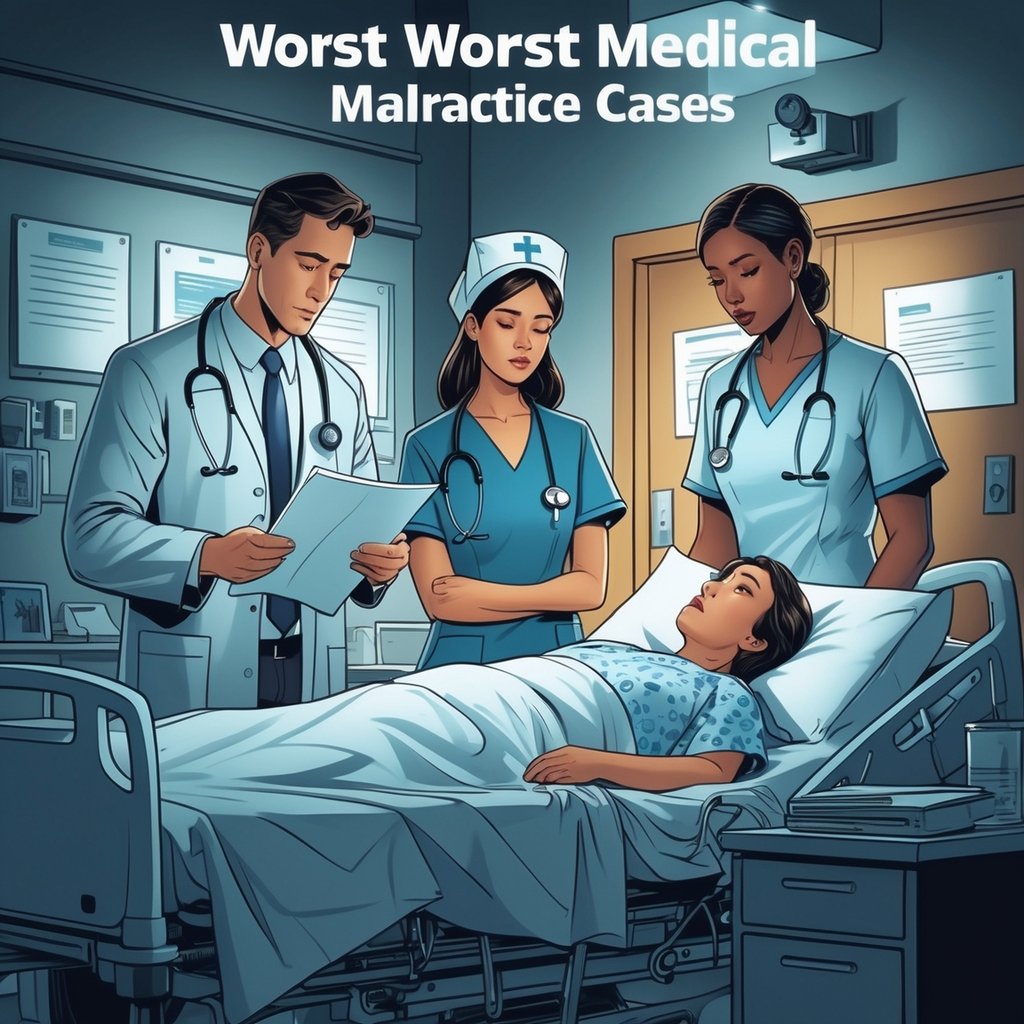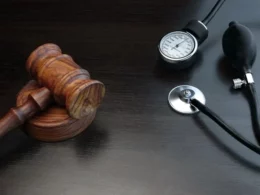Medical errors devastate patients and families every year in the United States. Between 200,000 and 400,000 people die each year from preventable medical mistakes, according to independent studies.
These statistics represent real people whose lives changed forever due to negligent care.

Some of the worst medical malpractice cases involve mistakes so severe they feel unreal. From wrong-site surgeries on patients’ heads to doctors removing healthy organs, these stories show failures in basic protocols.
Simple oversights can spiral into catastrophic outcomes. It’s honestly hard to believe sometimes.
Key Takeaways
- Medical malpractice kills hundreds of thousands of Americans each year due to preventable errors
- The worst cases involve shocking mistakes like wrong-site surgeries and organ mix-ups that should never happen
- Learning from these tragic cases helps improve patient safety and holds healthcare providers accountable
Defining Medical Malpractice and Its Consequences

Medical malpractice happens when healthcare professionals fail to provide appropriate care, and patients get hurt as a result. Knowing the legal definition, common causes, and possible outcomes helps people recognize when substandard care crosses the line.
What Constitutes Medical Malpractice
Medical malpractice means a healthcare provider doesn’t meet the standard of care that another qualified professional would provide in the same situation. This failure must directly cause injury or harm.
You have to prove that a clinician didn’t provide the degree of care another with the same credentials would have performed. Just having a bad outcome doesn’t mean malpractice happened.
Four key elements must be present:
- A doctor-patient relationship existed
- The healthcare provider breached the standard of care
- This breach directly caused your injury
- You suffered actual damages as a result
The standard of care changes depending on medical specialty, location, and available resources. What’s normal in an emergency room isn’t always expected in a planned surgery.
Common Causes of Medical Malpractice Cases
Medical errors that often lead to malpractice claims include misdiagnosis, surgical mistakes, and medication errors. Most of these incidents start with communication breakdowns or ignoring established protocols.
Most frequent causes include:
- Diagnostic errors: Missed, delayed, or wrong diagnoses
- Surgical mistakes: Wrong-site surgery, leaving instruments inside patients
- Medication errors: Wrong drugs, bad dosages, or dangerous interactions
- Birth injuries: Preventable complications during delivery
- Failure to obtain informed consent: Not explaining risks and alternatives
Wrong-site surgeries show how preventable errors still happen. Mistakes slip through even with safety protocols.
Medical staff often fail to communicate clearly. Poor documentation and rushed decisions can make things worse.
Potential Outcomes for Victims and Physicians
Medical malpractice hits both patients and healthcare providers hard. Victims may end up with lifelong medical bills, lost wages, and health problems that never go away.
For patients, consequences may include:
- More medical treatments and rehab
- Permanent disability or disfigurement
- Lost wages and less earning potential
- Pain, suffering, and emotional trauma
Some states cap the amount of compensation you can get in malpractice lawsuits. These limits may affect your recovery.
Healthcare providers face serious consequences:
- Higher malpractice insurance premiums
- Possible suspension or loss of license
- Damage to professional reputation
- Personal financial risk
About one in three clinicians get sued for malpractice during their careers. That’s a staggering rate and it shapes how medicine is practiced.
Legal battles drag on for years sometimes. Both sides deal with major stress and financial strain through the whole process.
Criteria for the Worst Medical Malpractice Cases

The most devastating medical malpractice cases share three factors. These determine how courts, the public, and the medical community view each incident.
Severity of Patient Harm and Injury
The amount of physical and emotional damage really defines how serious a malpractice case becomes. Death is the most severe outcome.
Permanent disabilities come next. Paralysis, brain damage, or losing limbs can change your life in ways you never expect.
Major categories of severe harm include:
- Wrongful death
- Permanent disability or disfigurement
- Loss of organ function
- Chronic pain conditions
- Need for lifelong medical care
Some cases involve so-called “never events”. These are mistakes that should never happen.
Operating on the wrong body part or leaving surgical tools inside a patient? That’s beyond unacceptable. Heart surgery on the wrong patient is a nightmare scenario.
Financial impact matters too. Medical bills, lost wages, and future care costs all play a role.
Legal Precedents and Significance
Cases that set new legal standards often stand out as the worst. These situations create rules to protect future patients.
Repeat offenders make cases even more significant. Doctors or hospitals with past malpractice issues get judged more harshly.
Key legal factors include:
- Settlement or verdict amounts
- Changes to medical practice standards
- Regulatory actions against providers
- Professional license suspensions
Most medical malpractice cases settle out of court. Fewer than ten percent go to trial.
The biggest settlements usually involve the most serious mistakes. High payouts reflect the true cost of negligence.
Cases that force hospitals to change policies or add training leave a lasting mark on the medical community.
Media Attention and Public Outcry
Public awareness increases the impact of a malpractice case. Media coverage brings attention to serious medical mistakes.
Celebrity cases or those with unusual circumstances get more attention. When a famous person suffers medical negligence, people notice.
Factors that increase media interest:
- Shocking or rare situations
- High-profile victims
- Repeated mistakes at the same facility
- Deaths of children or young adults
Social media spreads these stories fast. One post can reach thousands in an afternoon.
Public outcry often leads to policy changes. Hospitals and boards respond when communities demand better safety.
Media attention encourages other victims to come forward. When one story goes public, similar cases often surface.
Infamous Surgical Errors

Surgical mistakes make up some of the most shocking malpractice cases in medicine. These include operating on the wrong body part, leaving tools inside patients, and removing healthy organs.
Wrong Site and Wrong Patient Surgeries
Wrong site surgery means doctors operate on the wrong spot or even the wrong patient. These are “never events” and, honestly, it’s wild they still happen.
Rhode Island Hospital made headlines in 2007 after neurosurgeons performed wrong-site surgeries on three patients’ heads. Two mistakes got caught in time, but the third cost an 86-year-old patient’s life.
Willie King’s case is unforgettable. In 1995, surgeons amputated his healthy leg instead of the diseased one.
- Wrong leg listed on operating room blackboard
- Hospital computer system had incorrect info
- Wrong leg prepped and sterilized
The surgeon only got a $10,000 fine and a six-month license suspension. The case settled for $1.15 million.
Benjamin Houghton lost his healthy testicle at the West Los Angeles VA Medical Center. Unmarked records led to the mistake. The VA settled for $200,000.
Retention of Surgical Instruments
Sometimes surgeons leave tools inside patients. These foreign objects cause pain, infections, and more surgeries.
Donald Church went in for tumor removal at University of Washington Medical Center in 2000. Surgeons took out his tumor but left a 13-inch metal retractor in his abdomen.
He suffered two months of pain before doctors figured it out. He got $97,000 in damages. Shockingly, this was the hospital’s fifth such incident in five years.
Common retained objects include:
- Surgical sponges
- Clamps and forceps
- Needles and scalpels
- Retractors and spreaders
Most of these cases start with poor counting procedures. The operating room staff must count every instrument before and after surgery, but sometimes they don’t.
Operating on the Wrong Organ or Limb
Removing healthy organs instead of diseased ones leaves patients with permanent damage. These cases often come from misread test results or confusion in the operating room.
An 84-year-old woman went to Milford Regional Medical Center for gallbladder removal in 2006. Surgeon Patrick M. McEnaney took out her right kidney instead after misreading lab tests. The state medical board put him on five years probation.
Darrie Eason lost both breasts after a lab mix-up in 2007. CBL Path wrongly diagnosed her with breast cancer. Even a second opinion confirmed the error.
She had a double mastectomy before learning she never had cancer. Her case settled for $2.5 million.
Arturo Iturralde’s story is a jaw-dropper. His surgeon couldn’t find the right titanium rods for spine surgery, so Dr. Robert Ricketson pulled out a screwdriver handle and put it in Iturralde’s back.
The makeshift rod broke in days. Iturralde suffered severe pain and instability, and died within two years after multiple surgeries. His estate recovered $5.6 million.
Fatal Diagnostic and Treatment Mistakes

When healthcare providers misdiagnose conditions or fail to give proper treatment, patients can die from causes that should have been preventable. These malpractice cases often involve missed cancer diagnoses, delayed emergency care, or fatal medication errors that never should happen.
Misdiagnosis Leading to Death
Misdiagnosis is still one of the deadliest forms of medical malpractice. When doctors miss serious conditions like cancer, heart attacks, or infections, patients lose precious time for treatment.
Cancer Misdiagnosis Cases
- Breast cancer read as harmless tissue
- Lung cancer mistaken for pneumonia
- Skin cancer missed during routine checkups
The consequences can be devastating. A 35-year-old woman had a double mastectomy after lab mix-ups wrongly showed she had breast cancer.
Heart attack symptoms in women often get labeled as anxiety or indigestion. ER doctors sometimes send patients home with antacids instead of cardiac care.
These mistakes can turn deadly within hours.
Delayed Diagnosis or Treatment
Some medical conditions just can’t wait. When healthcare workers delay diagnosis or treatment, patients may die from problems that could’ve been fixed.
Critical Time-Sensitive Conditions:
- Stroke (treatment window: 3-4.5 hours)
- Heart attack (best treated within 90 minutes)
- Sepsis (risk rises every hour without care)
- Internal bleeding (needs surgery right away)
Emergency departments get a lot of scrutiny for slow care. Patients with chest pain, severe headaches, or infection signs need fast evaluation.
Triage errors that bump urgent cases down the line can be fatal.
Surgical delays also take lives. When surgeons put off needed operations due to scheduling or equipment problems, patients might get too sick for surgery to help.
Medication and Anesthesia Errors
Medication mistakes kill thousands of patients each year. These range from wrong drugs to anesthesia failures during surgery.
Common Fatal Medication Errors:
- Wrong drug: Patient gets chemotherapy instead of saline
- Dosage errors: Children given adult doses
- Dangerous drug combos: Prescribing meds that interact badly
Anesthesia errors can be especially brutal. In 2006, Sherman Sizemore suffered anesthetic awareness during surgery, staying awake and paralyzed. The trauma from this led to his suicide weeks later.
Photographer Bob East died when formaldehyde was injected into his spine instead of cerebrospinal fluid during eye surgery. The solution basically turned his organs to stone.
Pharmacy mistakes also kill when the wrong meds are given out or doses get miscalculated for a patient’s size or age.
High-Profile Medical Malpractice Lawsuits

Some medical malpractice cases have changed healthcare practices and public awareness in big ways. These cases include a young woman’s death that led to resident work hour reforms, a pop star’s fatal overdose, and a beloved actress losing her singing voice after surgery.
Libby Zion Case and Reform of Resident Work Hours
Libby Zion died in 1984 at New York Hospital, and her case became one of the most influential medical malpractice stories in the US. She was just 18 and treated by exhausted medical residents working extreme hours.
Key Case Details:
- Admitted with fever and agitation
- Residents worked 36-plus hour shifts
- Given conflicting meds that caused a fatal reaction
- Residents didn’t supervise care properly
The case exposed dangerous flaws in medical training. Residents worked as much as 120 hours a week with little rest. Exhaustion led to bad decisions and medical mistakes.
Libby’s father, Sidney Zion, pushed for reforms. His fight led to the Libby Zion Law in New York, which limited resident work hours and required better supervision.
These reforms spread across the country. Now, medical residents can’t work more than 80 hours a week and must get enough rest between shifts.
Michael Jackson Case: Celebrity and Medical Negligence
Dr. Conrad Murray’s care of Michael Jackson resulted in one of the most talked-about malpractice cases ever. Jackson died in 2009 from a propofol overdose given by his personal doctor.
Murray gave him propofol as a sleep aid at home. That drug belongs in hospitals with real monitors, not bedrooms. Murray left Jackson alone while the drug was still in his system.
Criminal and Civil Consequences:
- Murray convicted of involuntary manslaughter
- Sentenced to four years in prison
- Lost his medical license
- Jackson’s family won a $1.4 billion wrongful death lawsuit
The case showed the risks of celebrity medicine. Some doctors bend the rules for wealthy or famous patients, which creates dangerous situations.
Jackson’s death started new conversations about prescription drug abuse. It also reminded everyone that safety protocols matter, no matter who the patient is.
Julie Andrews Case: Surgery Altering a Career
Julie Andrews sued her doctors in 1999 after throat surgery permanently damaged her singing voice. She went in for what was supposed to be a routine surgery to remove benign throat nodules.
The surgery at Mount Sinai Hospital went wrong. Doctors accidentally cut her vocal cords.
That mistake destroyed her four-octave range and ended her stage career.
Impact on Andrews’ Career:
- Lost ability to hit high notes
- Couldn’t perform in musicals
- Had to retire from Broadway
- Sued for lost future earnings
Andrews settled the case for an undisclosed amount. The settlement likely covered lost income from canceled performances and future shows.
Her story shows how medical errors can ruin professional careers. For performers, losing their voice is a catastrophic injury.
The case also highlighted the need for specialists. Throat surgery for singers takes more expertise than most general surgeons have.
Landmark Jury Verdicts and Legal Repercussions

Juries have handed down record-breaking verdicts that push hospitals and doctors to change how they work. These cases set legal precedents and trigger regulatory reviews that affect hospitals everywhere.
Largest Verdicts in U.S. Medical Malpractice History
The biggest medical malpractice verdicts of 2025 show a trend toward larger jury awards. These cases usually involve catastrophic injuries that need lifelong care.
Georgia’s Record-Setting Awards:
- $70 million for vasopressin overdose causing double amputation
- $40 million for stroke misdiagnosis resulting in locked-in syndrome
The Georgia vasopressin case was so clear that the jury decided in just 30 minutes.
Birth Injury Cases Lead Verdicts:
Missouri awarded $48.1 million in a prolonged labor case, including $20 million in punitive damages. The Missouri birth injury verdict is the largest in state history.
Wisconsin and New Jersey saw $29 million and $17 million verdicts for similar birth complications. These often involve not doing C-sections soon enough when babies are in distress.
Civil Penalties and Regulatory Actions
Malpractice verdicts launch investigations from state medical boards and federal agencies. Large verdicts often mean license suspensions or practice limits for the doctors involved.
State Medical Board Actions:
State boards review malpractice cases to decide if more discipline is needed. They can suspend licenses, require extra training, or demand supervision.
Medicare and Medicaid Penalties:
Hospitals with repeat malpractice cases may get less reimbursement. The Centers for Medicare & Medicaid Services track safety incidents.
Joint Commission Reviews:
The Joint Commission may do surprise surveys after big verdicts. These reviews look at hospital policies and can lead to lost accreditation.
Professional Liability Requirements:
Insurance companies often hike premiums or require extra coverage after big verdicts. Some doctors may even lose their insurance.
Impact on Hospital Policy and Procedure
Big verdicts force hospitals to overhaul safety protocols and oversight systems. These changes touch everything from surgeries to ER operations.
Enhanced Safety Protocols:
The New Mexico retained surgical instrument case with a $16.75 million verdict led to mandatory instrument counts and new detection tech. Hospitals now use radiofrequency tracking for surgical tools.
Communication System Overhauls:
Cases like the Georgia stroke misdiagnosis pushed hospitals to install direct lines between ER doctors and specialists. This cuts down on delays for critical consults.
Labor and Delivery Changes:
The Missouri case involving 12 hours of pushing changed delivery protocols nationwide. Hospitals have new guidelines for when to do C-sections during prolonged labor.
Documentation Requirements:
Big verdicts often involve poor documentation of care decisions. Hospitals now use electronic systems that make doctors record their reasoning for treatments in real time.
Lasting Impact and Lessons Learned

Medical malpractice cases drive real reforms in healthcare, patient safety protocols, and transparency rules. These changes protect future patients and reshape how medical workers make decisions.
Systemic Changes in Healthcare
The biggest malpractice verdicts of 2025 forced hospitals to change their policies. After cases like Jonathan Buckelew’s $40 million verdict, ERs now require mandatory neuro consults for stroke symptoms.
Key Changes Include:
- Stricter surgical instrument counts
- Better sterilization for devices
- Mandatory second opinions for risky procedures
- Improved transfer protocols between hospitals
Labor and delivery units face the most pressure. Birth injury cases keep leading to huge awards, so hospitals have tightened up their C-section policies.
Hospitals use electronic monitors that alert staff to fetal distress. These systems help prevent the delays that led to cerebral palsy cases worth tens of millions.
Patient Safety Initiatives
Medical facilities now use safety programs based on patterns in malpractice cases. Your hospital probably does timeouts before surgery to double check patient identity and planned procedures.
Safety Measures Now Standard:
- Universal surgical checklists
- Medication verification systems
- Patient ID protocols
- Incident reporting rules
Communication training is now required for medical staff. Many misdiagnosis cases start with lousy communication between departments or shifts.
Standardized handoff procedures keep track of patient changes so nothing gets lost during transitions.
Technology helps prevent errors. Electronic health records flag drug interactions and allergies that used to slip through.
Importance of Accountability and Transparency
Malpractice litigation made transparency a legal requirement. Patients can now access hospital quality ratings and physician disciplinary records online.
Transparency Requirements:
- Doctors must disclose errors to patients
- Hospitals report infection rates publicly
- Patients can verify physician credentials
- Hospital safety scores are available
Accountability now covers whole healthcare systems, not just individual doctors. Notable cases show that institutional policies can cause harm.
Patients have the right to honest explanations when things go wrong. Many states require doctors to apologize and explain mistakes, and these admissions can’t be used in court.
Licensing boards have stepped up discipline. Doctors can lose their licenses or face restrictions based on patterns of malpractice.
Frequently Asked Questions
Medical malpractice cases are complicated and raise a lot of questions. The worst cases often involve wrong-site surgeries, medication mistakes, and failures in monitoring that lead to death or permanent disability.
What are some notable medical malpractice case stories?
You can find several disturbing cases of medical malpractice that really show just how severe these incidents can get. Dana Carvey’s case still stands out as one of the most publicized.
The Saturday Night Live comedian went in for a double bypass surgery in 2001. Two months later, he learned the surgeon had bypassed the wrong artery.
Carvey filed a $7.5 million lawsuit against both the surgeon and the hospital. That’s a pretty staggering error for such a high-profile patient.
Another shocking case involved a 67-year-old woman who got the wrong surgery entirely. She came in for a cerebral angiography but ended up on the table for open heart surgery.
They only caught the mistake after she’d already spent over an hour on the operating table. It’s hard to imagine how that even happens.
Willie King’s story shows just how devastating surgical errors can be. In 1995, surgeons amputated his healthy leg instead of the diseased one.
Once they realized the mistake, both legs needed amputation. The impact on his life must have been unimaginable.
Can you describe unusual instances of medical malpractice?
Some of the most outrageous malpractice cases involve situations that sound almost too bizarre to be real. A fertility clinic in New York mixed up sperm samples for Nancy Andrews.
Instead of her husband’s genetic material, the clinic used sperm from a donor of African descent. The error only became obvious when Baby Jessica was born with much darker skin than expected.
One Arizona case involved a 36-year-old brain injury patient who died after swallowing foreign objects. The autopsy uncovered ketchup packets, plastic bags, and paper towels in his stomach and bowels.
His family received an $11 million verdict against the assisted living facility. That kind of negligence just seems unfathomable.
Sherman Sizemore stayed awake during abdominal surgery and felt every cut for 16 minutes before doctors gave him anesthesia. The trauma reportedly led to his suicide two weeks later.
What recent medical malpractice cases have occurred in 2024?
Medical malpractice cases in 2024 seem to follow the same patterns as those in the past. Hospital systems keep facing lawsuits for surgical errors and diagnostic mistakes.
Emergency room negligence cases have gone up, especially for delayed treatment and misdiagnosis. Technology failures and electronic health record errors show up in many of these recent cases.
Telehealth malpractice claims have started to pop up more often. These usually involve misdiagnosis during virtual visits or poor follow-up care.
What significant medical malpractice cases have surfaced in the past five years?
The last five years have brought several high-profile settlements over $10 million. Most involve birth injuries and surgical errors at large hospital systems.
Prescription drug mix-ups have caused multiple wrongful death cases. Hospitals now face more scrutiny over staff shortages that lead to patient neglect.
Cancer misdiagnosis cases have led to big verdicts. Delayed cancer treatment often brings the highest compensation for patients and families.
Where can I find scholarly articles about medical malpractice cases?
You can find scholarly articles in medical journals and legal databases. PubMed has peer-reviewed research on medical errors and prevention.
Legal databases like Westlaw and LexisNexis offer detailed case law analysis. Many law schools open their medical malpractice research collections to the public.
The Journal of Patient Safety publishes studies on medical errors and how to prevent them. Medical associations often keep libraries of malpractice case studies for educational use.
What are the most famous medical malpractice cases that have taken place in Texas?
Texas has seen several notable malpractice cases. Its huge population and sprawling medical centers set the stage for some truly wild stories.
Houston’s medical center stands out with multiple high-profile lawsuits. Complex surgeries and experimental treatments at big teaching hospitals seem to attract controversy.
Dallas area hospitals have also landed in court over emergency room care and surgical mistakes. Birth injuries pop up often at Texas delivery centers, and those cases can get especially heated.












